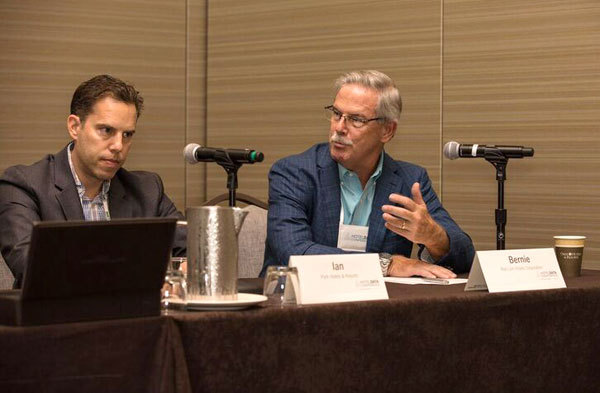✕

Column: industry Tag: culture,transparency,hotel acquisition Published: 2017-08-28 09:52 Source: Author:

Ian Weissman (left), of Park Hotels & Resorts, and Bernie Moyle, of RLH Corporation, participate in panel titled “How consolidation leads to a growing industry” during the 2017 Hotel Data Conference. (Photo: Event Coverage Nashville)
NASHVILLE, Tennessee—There’s a lot that goes into the consolidation process, and much of it has to do with hotel companies assessing each other’s cultures, looking at past cycles and putting a focus on guests, sources said.
Panelists for the “How consolidation leads to a growing industry” session at the 2017 Hotel Data Conference?agreed that the most important factor in a merger or acquisition is having a good mix in company culture, but in some cases it’s OK for the culture not to work out.
When there is an initial clash between the two companies involved in consolidation, that might indicate it was probably a bad deal from the start, said Bernie Moyle, EVP and COO of RLH Corporation.
But when a deal is considered beneficial for both sides, he said, that’s when the focus is just on the portfolio being acquired.
“We did a small acquisition a few years ago where we were acquiring a portfolio,” he said. “We weren’t worried about the culture, we were interested in the portfolio, and when we acquired the contracts, we took over the portfolio and we exited within six months. Everybody was gone … because we knew the culture wasn’t going to work.”
If the idea were to have kept those people along with the portfolio, he added, it would have been a horrible mistake.
About 30% of employees involved in a merger or acquisition are gone within a year, he said. Some don’t like change, and when they see positions being eliminated, they fear they might lose their job and pre-emptively look for another one, he said
Moyle described his experience when RLHC?acquired Vantage Hospitality in October 2016, which didn’t go as smoothly when the cultures mixed at first. It took about six months for employees to believe in him.
“That’s part of the culture shift,” he said. “Some people below my level had some difficulty with me coming in the position that I had.”
When that happens, Moyle said there are two ways to deal with that—either deal with it forcefully or deal with it in a friendly way. He chose the latter.
“Sometimes it just takes time,” he said. “You just have to maintain a steady course, keep open communication, always do what I say I’m going to do until these folks learn they can believe in me and trust me. Because they don’t know me. I’m the acquired.”
Lessons from Marriott-Starwood
Panelists were asked to reflect on Marriot International’s 2016 acquisition?of Starwood Hotels & Resorts Worldwide. Gerry Chase, president and COO of New Castle Hotels & Resorts, spoke about what worked and didn’t from an owner’s point of view in the megadeal.
“It was much better than I anticipated. … There was constant communication and updates on what is occurring, why and where,” he said. “What hasn’t happened … I really thought we would have experienced more lift on Starwood properties.”
Chase said that he was curious to see how the customer would be dealt with from a rewards standpoint, which he described as “very different rewards programs to be merged together.”
He said the teams had many ongoing meetings regarding how programs would be honored.
“When rewards were played in, they (Marriott) honored and kept in place the (Starwood Preferred Guests) program with all of those benefit,” Chase said. “In fact, they took the Marriott rewards program and matched it, even though it’s more expensive, they thought it was worth it to take care of the customers.”
And so far, it’s been a win-win for the guest, said Jack Levy, SVP of finance at Pyramid Hotel Group.
Future M&A landscape
From a management standpoint, Chase said he foresees a lot more consolidation happening over the next 10 years.
Ian Weissman, SVP of corporate strategy at Park Hotels & Resorts, said that although consolidation doesn’t occur too often among real estate investment trusts—since it is enormously challenging, he added—the next cycle will see REITs acquiring “not just in the top five or six markets, you’re going to see them acquiring in some of those top 20 (metropolitan statistical areas).”
Levy said he has definitely seen some of the REITs move more toward independent management companies as opposed to brand-managed companies.
And for some companies, it’s the right time to cash out, Chase added.
“There’s probably never been a better time for that,” he said.
How M&A has changed
Weissman said in comparison to past cycles, one thing he has noticed that’s different now is the use of leverage in consolidation. And the balance sheet today is much more focused on management teams than it was before, he said.
“Capital is still pretty available, but look at REITs for a second, they’ve been sellers recently and they probably shouldn’t (sell) in the cycle, but they’re very focused on taking leverage as low as they can,” Weissman said. “So whether they’re preparing to sell on a rainy day, or just worried about the cycle, I think the balance-sheet integrity is probably the biggest differential than it was in other cycles.”
Levy said in today’s landscape, there is more transparency and more information available beyond just the public financial statements.
“There’s all kinds of other reports and other analysts out there, so we have a pretty good idea of where all the assets are for the REITs,” he said. “We haven’t been able to get our arms around that before.”
Previous:Rock ’n’ roll stars influence hotel design, stays
Next:The Hotel Industry in the Central/South America Region Reports Postive Results for July 2017
Hot key words
Hot Products
Popular Vendors